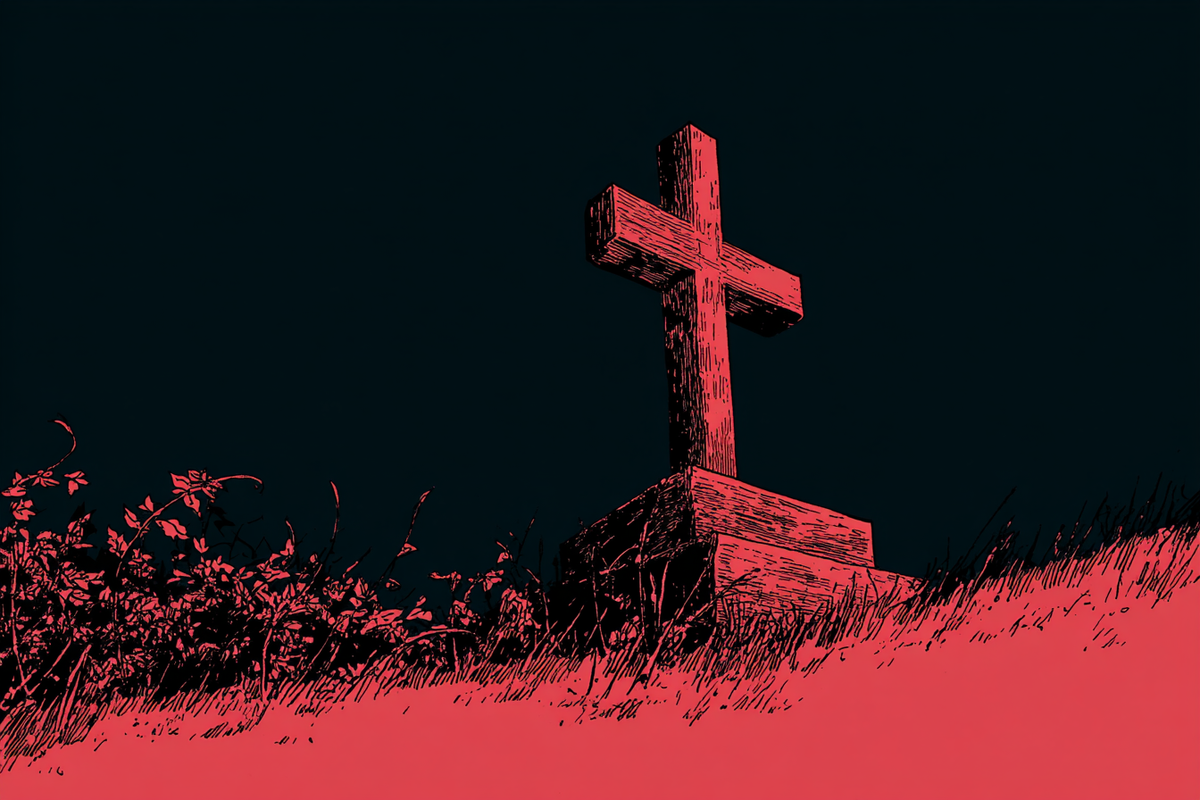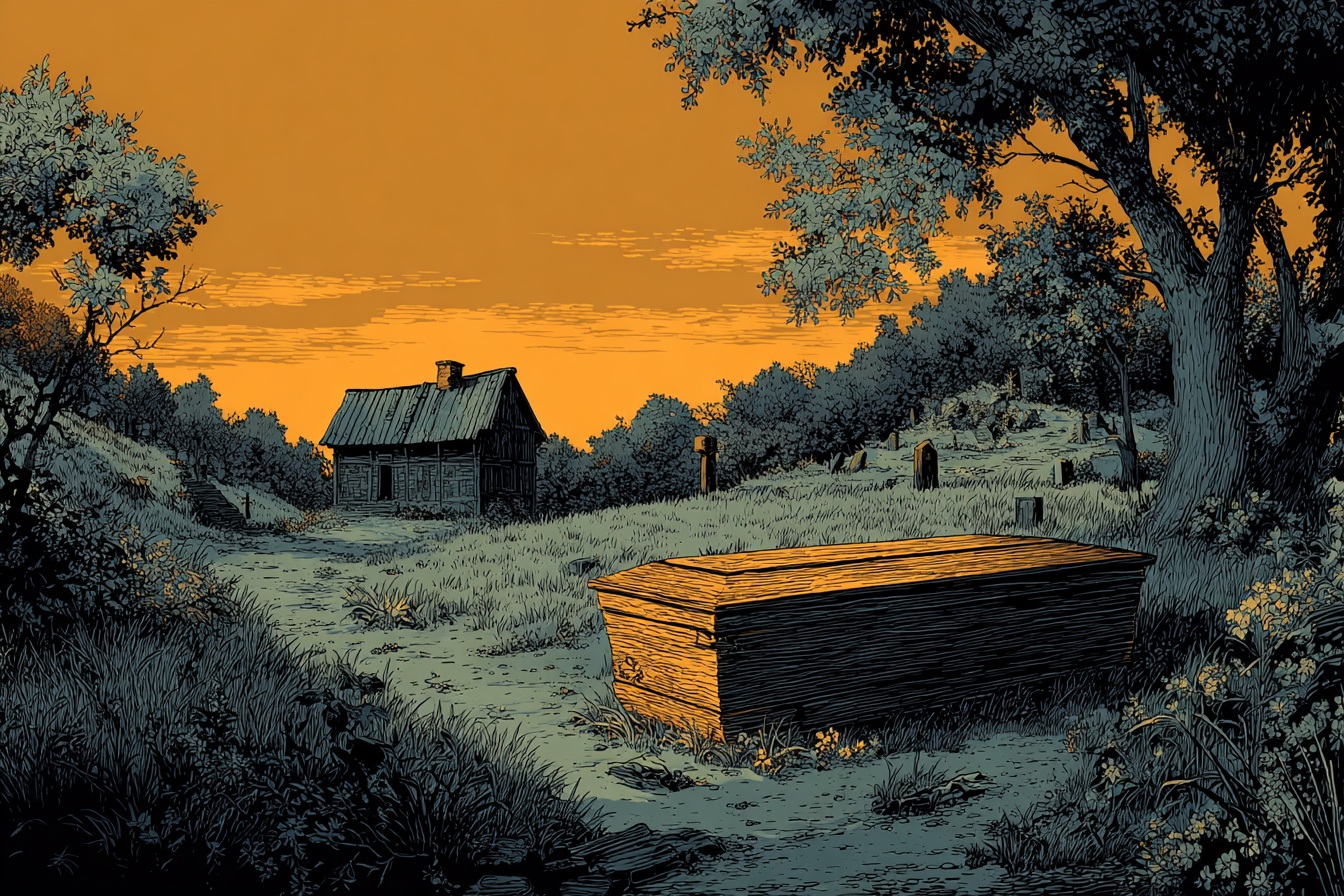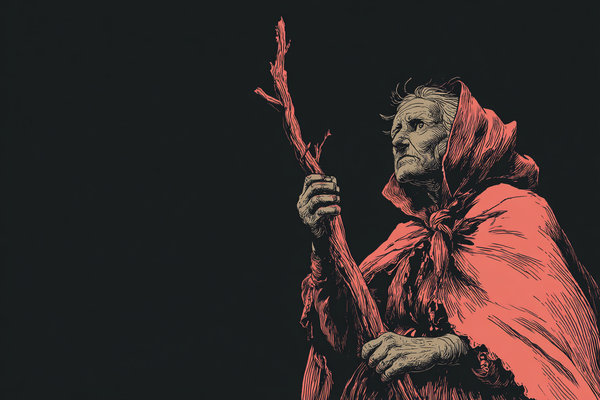The Medveđa Vampire Panic: Uncovering the Truth of the Arnold Paole Haunting

In the winter of the early 1700s, a small Serbian village became the stage for one of Europe’s most infamous vampire scares. The death of a soldier named Arnold Paole would spark whispers of the undead, draw the attention of Austrian military doctors, and send shockwaves across the continent. What happened in Medveđa was more than a local superstition—it became the case that gave vampires their place in European imagination.
Who was Arnold Paole?
Among history's most unsettling supernatural accounts, the case of Arnold Paole stands as remarkably well-documented. His name, recorded as "Arnont Paule" in German documents, was likely a rendering of the Serbian Арнаут Павле (Arnaut Pavle). This nomenclature is significant: "Pavle" is the Serbian form of Paul, but "Arnaut" (Арнаут) was a Turkish term often used to denote Albanians or those from Albanian-inhabited lands. Thus, Arnold Paole may have been known as "Pavle the Albanian."
This possible identity sheds new light on Paole's background. A Serbian hajduk—a kind of outlaw fighter—he often talked about being attacked by a vampire in a place called "Gossowa," thought to be Kosovo, an area with strong ties to Albanian history. If Paole was truly "Arnaut," his earlier run-in with a vampire in Kosovo takes on added cultural and regional meaning. He said he healed himself using dark traditional cures: eating dirt from the vampire's grave and rubbing himself with its blood.
Possibly marked by the trauma of a previous vampiric assault, he died around 1726 in his adopted village of Medveđa, which lay on the West Morava river near Trstenik and is distinct from the modern town of the same name in southern Serbia.
His accidental death triggered a horrifying vampire panic. Meticulously documented by Austrian military officials and physicians, the subsequent investigation propelled the belief in vampires across Enlightenment Europe and helped shape the terrifying archetype for generations.
A Frontier Forged in Conflict and Superstition
These events took place in the unstable border area between Austria and the Ottoman Empire. After the 1718 Treaty of Passarowitz, the Habsburg rulers took control of parts of Serbia, including Medveđa. These areas had few people and were damaged by war. The Austrians tried to make the region safe by hiring locals, like Paole, into fighting groups. It was in these frontier communities, full of local beliefs and fears from recent fighting, that some of the first well-recorded vampire scares happened.
During this time when Austria controlled the area, the border regions were ruled directly by the military from Vienna. The area was in bad shape because of the harsh fighting between the Austrians and Ottomans before. Few people lived there, many moved around rather than settling, farming was limited, and the economy mostly depended on raising cattle. Austrian leaders wanted to make these territories stable and developed, encouraging people to settle there, especially German-speaking Serbs. One main plan was to recruit local Serbs—many of whom were former hajduks (fighters who were often seen as heroes or rebels against Ottoman rule)—into military groups. These men guarded the borders during peacetime and fought in wars, and in return they got land that couldn't be taken away from them. It was in these newly settled, often unstable communities with strong beliefs in the supernatural that some of the earliest and best-documented vampire scares, including Arnold Paole's case, started to appear.
The First Shadow: Arnold Paole's Death and the Unseen Tormentor
The story, pieced together from Flückinger's later report that relayed the locals' accounts, begins with Arnold Paole himself. A hajduk by trade, Paole was relatively new to Medveđa, having moved from an area of Serbia under Turkish control. He admitted that he was no stranger to the supernatural. He often talked about a frightening experience in a place he called "Gossowa" (thought to be Kosovo), where he said he had been tormented by a vampire. Paole believed he had healed himself from this affliction through traditional folk rituals: eating soil from the vampire's grave and applying its blood to himself.
Around 1725, Paole met a simple, yet tragic, end. He died from injuries he got in a fall from a haywagon, specifically a broken neck. However, the ordinary nature of his death soon turned into incredible fear. Within just 20 to 30 days after his burial, four villagers began to say they were being "haunted" by the dead Paole. All four of them died soon after, spreading fear throughout Medveđa.
Fear grew rapidly. About ten days after the first deaths, and forty days after Paole's own death, the villagers, led by their hadnack (a local leader with experience in dealing with such terrible situations), decided to take action. They dug up Arnold Paole's body.
The sight that confronted them, as later documented, became a chilling catalogue of supposed vampiric traits. Paole's corpse was described as "undecomposed." More disturbingly, fresh blood was reportedly observed at his eyes, nose, mouth, and ears. His veins were said to be engorged with "fluid-blood." According to the account, "the shirt, the covering, and the coffin were completely bloody." It was also claimed that "the old nails on his hands and feet, along with the skin, had fallen off, and that new ones had grown." Furthermore, his body appeared "red," and his hair, nails, and beard seemed to have undergone post-mortem growth.
Convinced beyond doubt that Paole was a vampire, the villagers performed the customary, brutal ritual. They drove a stake through his heart, to which the corpse allegedly reacted with a "frightful shriek as if he were alive, groaning and bleeding." Following this, they decapitated him and burned the entire body. To ensure the contagion was contained, the four individuals believed to be Paole's initial victims were also disinterred and subjected to the same grisly procedures, lest they too rise as vampires. For a time, it seemed the horror had been purged.
The Quiet Before the Storm: A False Break and a Brutal Comeback
For about five years, a shaky peace hung over Medveđa. But in the brutal winter of 1731, death came back with force. A new epidemic spread through the village, taking more than ten lives in just a few weeks. Some people died quickly, within two or three days of getting sick, showing no previous signs of illness. Others experienced a longer decline. The exact number and ages of those who died differ a little in the main sources – the reports by Glaser and Flückinger.
Dr. Glaser's report, written on December 12, 1731, says that thirteen people had died over six weeks. He listed the victims, including: Miliza (Serbian: Milica), a 50-year-old woman; Milloi (Miloje), a 14-year-old boy; Joachim, a 15-year-old boy; Peter (Petar), a just 15-day-old baby; Stanno (Stana), a 20-year-old woman, and her newborn child (whom Glaser noted was buried "behind a fence, where the mother had lived" because she had not lived long enough for baptism); Wutschiza (Vučica), a nine-year-old boy; Milosova (Milosava), the 30-year-old wife of a hajduk; Radi (Rade), a 24-year-old man; and Ruschiza (Ružica), a 40-year-old woman. Those affected complained of sharp, stabbing pains in their sides and chest, continuous fever, and convulsive shaking of their limbs.
According to Glaser, the villagers quickly recognized Milica and Stana as the sources of this new wave of vampirism. Milica had come to Medveđa from land controlled by the Ottomans six years earlier. Although she was generally seen as a good neighbor who had never, to their knowledge, done anything "evil," she had once mentioned casually that she ate two sheep that had been killed by vampires while she was still living in Ottoman lands. Stana, on the other hand, reportedly admitted to covering herself in vampire blood in Ottoman territory as a protective measure against vampires, which were said to be common there. Local belief held that both of these actions condemned the women to become vampires after they died.
Flückinger's later report, covering events up to January 7, 1732, stated that seventeen people had died over a three-month period (the last two deaths appeared to happen after Glaser's visit). His list included: Miliza (Milica), described as a 69-year-old woman who died after being ill for three months; an unnamed 8-year-old child; Milloe (Miloje), a 16-year-old boy who died after being sick for three days; Stana, a 20-year-old woman who died in childbirth after a three-day illness (Flückinger noted that she reportedly said she had covered herself with vampire blood), along with her stillborn child (which Flückinger sadly observed was "half-eaten by dogs due to a careless burial"); an unnamed 10-year-old girl; Joachim, a 17-year-old who died after being ill for three days; the hadnack's unnamed wife; Ruscha (Ruža, a version of Ružica), a woman who died after a ten-day illness; Staniko (Stanjko), a 60-year-old man; another Miloe (Miloje), the second victim with that name, a 25-year-old man; Ruža's 18-day-old child; Rhade (Rade), a 21-year-old servant of the local hajduk corporal, who died after being sick for three months; the local standard-bearer's (barjaktar's) unnamed wife (likely the Milosava from Glaser's report) along with her child; the hadnack's eight-week-old child; and Stanoicka (Stanojka), a 20-year-old wife of a hajduk, who died after being ill for three days.
A particularly disturbing story involved Stanojka. Her father-in-law, Joviza (Jovica), stated that Stanojka had gone to bed in good health fifteen days earlier but had woken up at midnight, frightened and screaming that she had been choked by the recently deceased Miloje (the son of Hajduk Milo, who had died nine weeks earlier, according to Calmet's later analysis). From that moment on, Stanojka fell into a weak state and died three days later. This claim quickly pointed to Miloje as a vampire.
Flückinger reported that the villagers believed this new outbreak was caused by Milica, the first to die in this second wave, because she had eaten meat from sheep killed by the "previous vampires"—Arnold Paole and his victims from five years ago. He also mentioned, almost in passing, the claims that Stana had confessed, before her death, to covering herself in vampire blood for protection, an action that, along with her child, would lead to her becoming a vampire. Augustin Calmet, in his analysis, added another point: "They finally discovered, after much searching, that the deceased Arnold Paul had not only killed the four people we talked about but also several oxen, which the new vampires had eaten, including Millo's son." This indicated a chain of infection through the consumption of animal flesh.

The Imperial Gaze: Austrian Authorities Investigate
The escalating death toll and the palpable terror of the villagers eventually reached Oberstleutnant Schnezzer, the Austrian military commander responsible for the area's administration. Schnezzer, fearing a potential outbreak of pestilence, dispatched Imperial Contagions-Medicus Glaser from the nearby town of Paraćin to investigate.
On December 12, 1731, Glaser arrived in Medveđa. He carefully examined the sick villagers and their homes but found no clear signs of an known contagious disease. He first thought the deaths were due to the widespread hunger in the area and the possibly harmful effects of the strict Eastern Orthodox fasting rules. However, the villagers were not convinced. They firmly believed that vampires were causing their problems. Some families had begun to gather at night, with some people taking turns sleeping while others kept a scared watch. They strongly insisted that the deaths would not stop unless the authorities allowed the "killing" of the suspected vampires, even threatening to leave their village all together to save themselves if their requests were ignored.
Confronted with this strong belief and the risk of social chaos, Glaser hesitantly agreed to dig up some of the recently buried bodies. What he saw clearly shocked him. He noted that most of the exhumed bodies were not decomposed; many looked swollen, and several had blood in their mouths. In contrast, a few others who had died more recently (specifically Vučica, Milosava, and Rade) were much more decomposed. In his official report to the Jagodina commandant's office, Glaser detailed his findings and importantly, suggested that the authorities calm the frightened public by meeting their demands to “execute” the suspected vampires. Schnezzer sent Glaser's report up the chain of command to the Supreme Command in Belgrade (then under Austrian control). The vice-commandant, Botta Adorno, responded by sending a second, more formal team to Medveđa.
This new commission, which arrived in January 1732, was a more formidable investigative team. It included military surgeon Johann Flückinger, Lieutenant Colonel Büttner, J.H. von Lindenfels, and two other military surgeons, Siegele and Johann Friedrich Baumgarten. On January 7, accompanied by village elders and local Gypsies (who were often tasked with the grim work of exhumation and dispatch), the commission began opening the graves of those who had died in the second outbreak.
Their findings mostly supported Glaser's earlier observations but were recorded with much more anatomical detail in Flückinger's later report. The commission determined that out of the seventeen bodies examined (the total number of deceased varies a bit across reports), five—the hadnack's wife and child, Rade, and the standard-bearer's wife and child—were discovered in an advanced state of decay.
However, the remaining twelve corpses were described as "quite complete and undecayed" and exhibited the precise characteristics commonly associated with vampirism in the local belief system. Their chests, and in some cases other organs, were reportedly filled with fresh, uncoagulated blood. Their viscera (internal organs) were assessed as being in "good condition." The corpses generally appeared plump, and their skin retained a "red and vivid" color, rather than the expected pallor of death. In several instances, it was meticulously noted that "the skin on ... hands and feet, along with the old nails, fell away on their own, but on the other hand completely new nails were evident, along with a fresh and vivid skin."
The case of Milica (the 69-year-old woman) was particularly striking to the hajduks assisting with the dissection. They recalled her as having been "lean and dried-up" throughout her life, and were astonished to find her body plump in the grave. The surgeons collectively described these bodies as being in a "vampiric condition" (Vampyrenstand).
Following the thorough examination, the Gypsies, under the commission's observation, decapitated the supposed vampires, burned both their heads and bodies, and cast the ashes into the West Morava river. The bodies that were found to be decomposed were simply reinterred. Flückinger's comprehensive report, formally dated January 26, 1732, from Belgrade, bore the signatures of all five participating Austrian officials.
The story of Arnold Paole and the Medveđa vampires quickly spread beyond the Serbian frontier. On February 13, 1732, Dr. Johann Friedrich Glaser, the father of the initial investigator and a correspondent for the Nuremberg journal Commercium Litterarium, sent the editors a letter detailing the entire affair as recounted to him by his son (who had written to him on January 18). This letter, alongside both official reports (especially Flückinger's more detailed account), was reprinted in numerous articles and scholarly treatises, igniting widespread interest and debate across Europe.
Calmet noted the thoroughness of the official response: "All the information and executions we have just mentioned were made judicial, in proper form, and attested by several officers who were garrisoned in the country, by the chief surgeons of the regiments, and by the principal inhabitants of the place. The verbal process of it was sent towards the end of last January to the Imperial Counsel of War at Vienna, which had established a military commission to examine into the truth of all these circumstances."
Peeling Back the Shroud: Modern Explanations for Ancient Terrors
While the 18th-century reports from Medveđa lent an air of official validation to vampirism, modern science provides far more prosaic, though no less fascinating, explanations for the "vampiric condition" observed by Glaser and Flückinger. The seemingly supernatural state of the corpses can be attributed to natural decomposition processes occurring under specific environmental conditions:
- Delayed Decomposition: Burial in cold, damp, or anaerobic (oxygen-poor) soil can significantly inhibit the natural decay process, leading to bodies appearing remarkably preserved for extended periods.
- Bloating and "Plumpness": As internal organs decompose, bacteria produce gases (such as methane, hydrogen sulfide, and carbon dioxide). These gases accumulate within the body cavities, causing the torso and limbs to swell, giving the corpse a "plump" or "well-fed" appearance – a stark contrast if the individual was thin in life, as noted with Milica.
- "Fresh Blood": The pressure exerted by these internal gases can force decomposition fluids, often stained dark reddish-brown by degraded blood (hemolyzed blood), out of natural orifices like the mouth, nose, and ears. This dark, viscous fluid could easily be mistaken for fresh, liquid blood by untrained or terrified observers.
- Skin and Nail "Growth": The illusion of post-mortem hair and nail growth is a well-understood phenomenon. As the body dehydrates, the skin retracts, particularly around the nail beds and hair follicles. This exposes more of the nail and hair shaft, creating the appearance of growth. Similarly, the outer layers of skin (epidermis) can loosen and slough off ("skin slip"), sometimes revealing newer-looking skin underneath or causing old nails to detach, which might be misinterpreted as new nail growth.
- Sounds from the Corpse: The "frightful shriek" or groans reportedly emitted when Paole's body was staked can be explained by the forceful expulsion of trapped putrefaction gases through the trachea (windpipe) as the chest cavity is pierced or manipulated.
The local beliefs regarding the transmission of vampirism—eating sheep killed by vampires, or self-anointing with vampire blood—further underscore the potent interplay of cultural folklore and psychological contagion. Paole's own tales of his encounters in "Gossowa" had already primed the community for such interpretations. Subsequent unexplained deaths, especially during harsh winters when illness was common and food scarce, were readily filtered through this terrifying, pre-existing framework.
The Enduring Echo of Arnold Paole
The case of Arnold Paole, along with that of Petar Blagojević, represents a key moment in how Western Europe viewed and understood vampires. The detailed and formal reports by Austrian military personnel, especially doctors, added an unsettling sense of realness to stories that belonged purely to folklore. These reports, spread widely, offered a wealth of "evidence" that intrigued an Enlightenment-era audience—one that, despite its growing emphasis on reason, remained captivated by the strange, the unusual, and the mysterious.
The "vampires" of Medveđa were likely not supernatural beings but rather unfortunate individuals misunderstood and feared because of the limited medical and forensic knowledge of the 18th century. Nevertheless, their story, carefully documented and widely shared, helped shape the image of the vampire in European thought: the decaying corpse, swollen with the blood of its victims, its nails and hair still growing, a sinister figure rising from the grave to hunt the living.
Although the soil of Medveđa has long been at rest, and Arnold Paole is likely at peace, his name and the frightening events surrounding his death and rumored return continue to echo. The case serves as a strong reminder of how community fear, old beliefs, and the mysterious nature of death can come together to form lasting myths. It also shows how even official efforts to understand and manage such situations can unknowingly add to the very stories they aim to explore, ensuring that the shadow of the vampire reaches far beyond the Serbian border and deep into the heart of Western thought.





